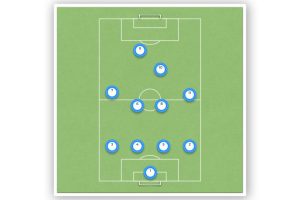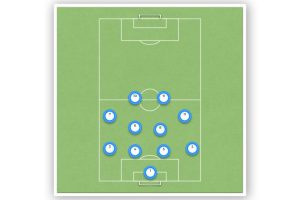How to Defend in a Back 5 or Back 3 in Soccer
Defending in soccer is crucial, and utilizing a back five system can provide a solid defensive foundation. This system requires a deep understanding of various defensive strategies to be effective.
The back five formation is designed to add an extra layer of security, featuring three central defenders flanked by two wing-backs. Despite its inherently defensive nature, the back five can be adapted for different defensive tactics, including the mid-block, high press, and deep defending.

In a mid-block, the defensive unit focuses on controlling the middle third of the field, operating neither too close to their goal line nor too high up the pitch. This allows for a balance between defensive solidity and the ability to spring into attack.
When employing a high press, the back five pushes up the field, aggressively challenging opponents and seeking to regain possession quickly. Conversely, deep defending sees the back five drop closer to their own goal, often absorbing pressure and reducing the space for the opponent’s attackers.
Key Takeaways
- A back five system adds robustness to a team’s defensive setup.
- Different tactics like the mid-block, high press, and deep defending can be executed within this formation.
- The back five requires coordinated effort and understanding among defenders.
Understanding the Back 5 Formation
In soccer, mastering the back five formation is crucial for teams aiming to achieve a strong defensive line. This setup typically involves three central defenders flanked by two full-backs who may also operate as wing-backs, depending on the tactical approach.
Defining the Back 5
The back five is a defensive structure in soccer with five players forming the last line of defense before the goalkeeper. It’s composed of three central defenders providing solid coverage in the middle and two full-backs or wing-backs on the sides to balance defensive duties with width in attack. This formation is particularly effective against teams with a penchant for attacking through the wings, as it offers substantial coverage of wide areas.
- Central Defenders: The central trio are pivotal in maintaining defensive solidity. Their main job is to intercept passes, mark opposition forwards, and clear any threats from the box.
- Full-Backs/Wing-Backs: These players have a dual role: to support the central defenders in a direct defensive capacity and to provide width when in possession or transitioning into attack.
A back five can adapt to different types of defending such as using a mid-block, where the team sets up in a medium height on the pitch, applying pressure in the midfield. They can also deploy a high press strategy, challenging the opponent’s buildup early. Conversely, they might employ deep defending, sitting closer to their goal to frustrate teams that use the pace to break through.
The choice between these defensive styles depends on multiple factors, including the opponent’s strategy, the pace of the team’s defenders, and the tactical setup instructed by the coach.
Roles and Responsibilities in a Back Five or Back Three

In soccer, a back five or back three system relies on disciplined positioning and clear understanding of roles for successful defense. Whether a team opts for a mid block, high press, or deep defending will significantly influence the specific duties within these roles.
Centre-Backs
Centre-backs form the core of the defense, especially in a system with three central defenders. They are typically tasked with marking opposition strikers, intercepting passes, and contesting aerial duels.
In a back three, the central centre-back acts as the linchpin, providing cover and directing the defensive line. The two other centre-backs must possess the agility to manage wide threats, such as wingers, particularly when facing teams that utilize width. The ultimate coaching guide for such formations emphasizes the need for these players to collaborate closely and maintain formation integrity.
Wing-Backs
The wing-backs take on the roles of both full-backs and wingers; they must be dynamic in transition, offering width in attack and rapidly recovering to a defensive stance.
Their responsibilities in defense include pressing opposition full-backs, tracking back with wingers, and sometimes tucking in to form a five-man defense. This positioning allows the team to handle situations where they need to drop deep and absorb pressure.
Midfield Support
Midfielders in these systems have a dual role: support the defense by congesting the midfield and initiating counter-attacks after regaining possession.
Their commitment to defense entails zonal marking, closing down passing lanes, and providing an outlet for the wing-backs and centre-backs when they are in possession.
Goalkeeper as the Last Line
The goalkeeper’s realm extends beyond the goal line; they must play as the last line of defense and the first step in building an attack.
This requires not only shot-stopping but also command over the box, decisive clearances, and precise distribution under pressure.
When employing a high line or mid block, goalkeepers need to be proactive, often coming off their line to intercept through balls that bypass the defensive line. They also serve as the back three’s support, providing critical communication that keeps the defensive structure organized.
Basic Defensive Principles
A successful back five defense in soccer relies on a symbiotic relationship between compactness, space management, and disciplined communication. By mastering these concepts, a team can create a formidable defensive unit capable of thwarting various attacking strategies.
Compactness and Covering
Compactness is crucial in a back five system; it ensures that defenders stay close enough to support each other while limiting the space for opponents to exploit.
This is achieved by the defensive line moving as a coherent unit, maintaining a tight formation both horizontally and vertically.
The coaching the key principles of defending in a mid-block emphasizes the importance of a team being compact near the ball to effectively press the ball carrier.
Defensive midfielders also play a pivotal role in compactness. They act as a buffer zone, stifling attacks before they reach the defensive line, and covering space when the defensive line is breached.
Control of Width and Depth
Teams must control both width and depth to defend effectively.
By coordinating the back five to adjust their positions based on the ball’s location, teams can cover more ground and close down passing lanes.
The outside central defenders, crucial in managing the width of the pitch, should work in harmony with the wing-backs to counteract wide attacks and funnel opponents into less threatening areas of the pitch.
Depth is controlled by setting an organized line of engagement, whether it’s a deep-lying defense close to goal or a high press to disrupt opponents early.
Discipline and Communication
Discipline and communication are the foundation of any solid defense.
Players must adhere to their roles, resist the urge to chase the ball, and maintain shape under pressure.
Communication between the defenders and the goalkeeper ensures that everyone is aware of their responsibilities and alerts the team to shifts in the opponent’s attacking patterns.
Persistent verbal and non-verbal cues help maintain structure and facilitate the swift exchange of roles, for instance, when a center-back steps out of line to challenge an attacker, and a teammate provides cover.
The basic principles of team defense highlight the significance of guiding the ball carrier into the thickest part of the defense, a tactic made possible through disciplined communication.
Defensive Strategies with Five or Three at the Back
Executing a solid defensive strategy is essential when employing a 3-5-2, 3-4-3, or 5-3-2 formation. Understanding how to adapt to different phases of the game, such as deep defending, maintaining a mid-block, or applying a high press, becomes the cornerstone of a successful defense. These tactics hinge on collective coherence to restrict space and leverage triggers to regain possession.
Deep Defending
When they retreat to a deep defending stance, teams concentrate forces in the final third of the field.
Compactness is vital, as defenders and midfielders attempt to minimize the operational space for the opposing attackers.
Central to this approach is the discipline to maintain shape and synergy, ensuring limited gaps for opponents to exploit.
Teams well-versed in Mastering the 3-5-2 Soccer Formation: Tips and Strategies show how a unit can shift to a 5-3-2 to provide robust defense near their goal.
The Mid-Block
Employing a mid-block entails positioning the team’s defensive shape within the middle third of the pitch.
This strategy aims to balance the need for defensive solidity with the potential to launch counter-attacks upon retrieving the ball.
In a mid-block, the team stays compact but does not drop as deep, instead opting to control and squeeze the space around the centre circle.
Patience is key, as teams wait for specific triggers such as a loose touch or a predictable pass to initiate a press.
For a deeper understanding of this tactical setup, refer to The mid-block: football tactics explained.
Implementing the High Press
The high press demands a proactive attitude from the team out of possession. Here, defenders and midfielders push up to the opponents’ half to apply pressure on the ball carrier and nearby passing options.
The aim is to force errors and win back possession close to the opponent’s goal. A successful high press is meticulously organized, with each player understanding their role and responsively closing down space.
Effective pressing relies on collective movement and pressing triggers, such as a backward or sideways pass.
Insights on how to press effectively with varying formations can be gleaned from sources like How To Press A Back 3 – Defensive Tactics Using A 4-5-1.
Transition and Counter-Attack with a Back Five or Back Three
In soccer, transitioning from defense to attack is crucial, especially when operating with a back five or back three formation.
Such formations require disciplined coordination to effectively counter-attack while maintaining defensive security.
From Defense to Attack
When transitioning from defense to attack in a back five or back three, the key is to quickly turn regained possession into a scoring opportunity.
Defenders should look to relay the ball to midfielders or directly to forwards.
The wide center-backs, in a back three, may step into midfield with the ball, exploiting spaces left by the opposition’s attacking play.
Fullbacks or wing-backs are particularly important in a back five, as they provide width and can advance the ball rapidly down the flanks.
They need to understand the right moments to surge forward, keeping the integrity of the defensive line but also overlapping with midfielders to create numerical advantages on the wings.
Counter-Pressing Strategies
Counter-pressing strategies involve immediately applying pressure after losing the ball to regain possession high up the pitch.
This is crucial for teams employing a high press within a back five or back three formation.
The team must act as a cohesive unit; as soon as the ball is lost, nearby players swarm the opponent to prevent them from launching their own counter.
Intelligent positioning and tactical fouls can slow down the opposition’s counter-attacks and allow the team to recover its shape.
The timing of the press is critical – if done correctly, it can lead to winning the ball in advantageous positions, setting up potential counter-attacks with forwards already positioned to exploit the disorganized defense.
Training and Exercises for Defending in a Back Three
Training for defending in a back three focuses on building a resilient defensive unit capable of withstanding various types of offensive pressure.
Key points include the development of team shape, a thorough understanding of roles, and progression through drills designed to simulate match scenarios.
Drills for Defensive Cohesion
Defenders in a back three must act as one cohesive unit to effectively neutralize the opposition. Here are some specific exercises they can practice:
- Positional Rondo: This drill involves a circle of attackers passing the ball around a smaller group of defenders in the middle. The defenders work together to regain possession, enhancing their teamwork and spatial awareness.
- Compactness Exercise: In this drill, the back three must maintain a tight defensive shape while shifting laterally across the field. This improves their ability to defend as a unit against a side that utilizes the full width of the pitch.
These drills teach the back three to communicate, cover for each other, and move synchronously, which are crucial skills for effective defending.
Scenario-Based Training
Practical understanding comes from training in realistic conditions. Scenario-based training provides this by creating match-like situations:
- Set-Piece Defense: Coaches can set up free kicks and corners against the back three to work on their marking and set-piece organization. Instructions should emphasize clearing the ball and quick transitioning to offense after regaining possession.
- Counter-Attack Defense: This exercise simulates defending against a fast-breaking opponent. The back three practice retreating quickly, arranging themselves to cover key spaces, and stopping the opposition’s forward momentum.
Each scenario aims to challenge the defenders’ decision-making and adaptability, ensuring they can apply their skills in actual matches.
Through these exercises, the defensive trio can build a solid foundation for effective backline play.
Analyzing Professional Teams
When observing professional teams, specific strategies and formations stand out, particularly in the use of a back 5.
Atlético Madrid’s disciplined approach and Inter Milan’s tactical flexibility offer invaluable insights for keen observers of defensive play.
Case Study: Atlético Madrid Five at the Back
Diego Simeone’s Atlético Madrid is renowned for its robust defensive strategies, often employing a mid-block to stifle opponents.
Their five at the back formation involves disciplined wing-backs and a trio of central defenders who maintain compactness.
Playing in the high-intensity La Liga, they’ve consistently displayed a masterclass in deep defending, making them a model for aspiring defenders.
Learnings from Top Coaches
Observing professional coaches such as Diego Simeone, José Mourinho, and Pep Guardiola provides a comprehensive understanding of defensive strategies.
Each coach has imparted a unique philosophy on the teams they’ve led, demonstrating the importance of a well-structured defense.
These insights illustrate the significance of studying professional teams to understand the tactical nuances behind a successful five at the back system.
Frequently Asked Questions
In this section, you’ll find targeted advice to optimize the defensive capabilities of a back 5 in various game situations, from a solid mid-block to an aggressive high press, and deep defending.
What are effective strategies for a back 5 to defend in a mid-block setup?
Teams can achieve effectiveness in a mid-block setup by maintaining compactness horizontally across the field and vertically between the lines.
This ensures that the midfield and defense move in unison to close down spaces.
For deeper insights, read about mid-block football tactics.
How can a team utilizing a back 5 implement a successful high pressing system?
A back 5 can implement a high press by using the wing-backs to apply pressure on the opponent’s wide players, while the central defenders cover potential space behind.
Central midfielders must actively support this press to prevent the opposition from playing through the middle.
Explore the differences between high press and low block.
What are the key principles for a back 5 when defending deep in their own half?
When defending deep, the back 5 should focus on positional discipline, ensuring there’s no space for the opposition to exploit.
Communication and zonal marking become critical, as does the ability to quickly clear the ball under pressure.
Learn more about defending in a mid-block.
In what ways can the 5-3-2 formation be adjusted to enhance defensive stability?
Adjustments in a 5-3-2 to increase defensive stability include tightening the distances between the center-backs and using one midfielder as a defensive anchor to screen the defense.
This can help absorb pressure and counterattack effectively when regaining possession.
How should a team with a back 5 react to opponents using a low block strategy?
Against a low block, a back 5 should be patient, circulating the ball to draw opponents out and create space.
Overloading specific zones and utilizing the dribbling skills of the wing-backs can create breakthroughs.
Find out about breaking a low block with positional play.
What training exercises can help improve a back 5’s coordination during mid-block defending?
Training exercises like pattern play drills can improve coordination. In these drills, the back 5 shifts in response to ball movement.
Using small-sided games with specific mid-block defending objectives can also help. These games help players understand their roles and movements within the system.






